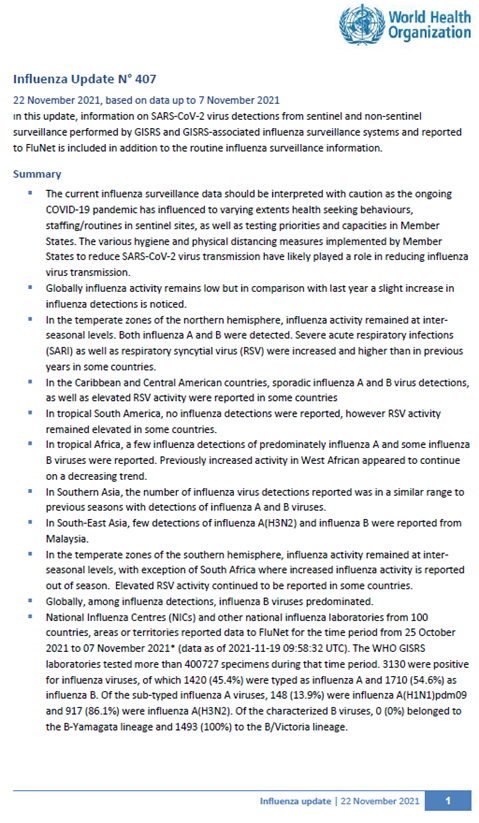Influenza Update N° 407

Overview
22 November 2021, based on data up to 7 Novemeber 2021
Information in this report is categorized by influenza transmission zones, which are geographical groups of countries, areas or territories with similar influenza transmission patterns. For more information on influenza transmission zones, see the link below:
Influenza Transmission Zones (pdf, 659kb)
- The current influenza surveillance data should be interpreted with caution as the ongoing COVID-19 pandemic has influenced to varying extents health seeking behaviours, staffing/routines in sentinel sites, as well as testing priorities and capacities in Member States. The various hygiene and physical distancing measures implemented by Member States to reduce SARS-CoV-2 virus transmission have likely played a role in reducing influenza virus transmission.
- Globally influenza activity remains low but in comparison with last year a slight increase in influenza detections is noticed.
- In the temperate zones of the northern hemisphere, influenza activity remained at inter-seasonal levels. Both influenza A and B were detected. Severe acute respiratory infections (SARI) as well as respiratory syncytial virus (RSV) were increased and higher than in previous years in some countries.
- In the Caribbean and Central American countries, sporadic influenza A and B virus detections, as well as elevated RSV activity were reported in some countries.
- In tropical South America, no influenza detections were reported, however RSV activity remained elevated in some countries.
- In tropical Africa, a few influenza detections of predominately influenza A and some influenza B viruses were reported. Previously increased activity in West African appeared to continue on a decreasing trend.
- In Southern Asia, the number of influenza virus detections reported was in a similar range to previous seasons with detections of influenza A and B viruses.
- In South-East Asia, few detections of influenza A(H3N2) and influenza B were reported from Malaysia.
- In the temperate zones of the southern hemisphere, influenza activity remained at inter-seasonal levels, with exception of South Africa where increased influenza activity is reported out of season. Elevated RSV activity continued to be reported in some countries.
- Globally, among influenza detections, influenza B viruses predominated.
- National Influenza Centres (NICs) and other national influenza laboratories from 100 countries, areas or territories reported data to FluNet for the time period from 25 October 2021 to 07 November 2021* (data as of 2021-11-19 09:58:32 UTC). The WHO GISRS laboratories tested more than 400727 specimens during that time period. 3130 were positive for influenza viruses, of which 1420 (45.4%) were typed as influenza A and 1710 (54.6%) as influenza B. Of the sub-typed influenza A viruses, 148 (13.9%) were influenza A(H1N1)pdm09 and 917 (86.1%) were influenza A(H3N2). Of the characterized B viruses, 0 (0%) belonged to the B-Yamagata lineage and 1493 (100%) to the B/Victoria lineage.

- During the COVID-19 pandemic, WHO encourages countries, especially those that have received the multiplex influenza and SARS-CoV-2 reagent kits from GISRS, to continue routine influenza surveillance, test samples from influenza surveillance sites for influenza and SARS-CoV-2 viruses where resources are available and report epidemiological and laboratory information in a timely manner to established regional and global platforms (see the guidance here: https://apps.who.int/iris/rest/bitstreams/1316069/retrieve).
- At the global level, SARS-CoV-2 percent positivity from sentinel surveillance continued to decrease. Activity remained ?under 10% positivity for all regions except the WHO region of the Americas and Europe. The WHO region of the Americas continued a downward trend in positivity and is currently 15%. The WHO European region observed an increase of about 4% and is also currently 15%. Overall positivity from non-sentinel sites continued to decrease, remaining just under 7%. While activity showed a decreasing trend among the WHO South-East Asian region non-sentinel sites, activity remained elevated and above 20%.
- National Influenza Centres (NICs) and other national influenza laboratories from 42 countries, areas or territories reported data to FluNet for the time period from six WHO regions (African Region: 1; Region of the Americas: 13; Eastern Mediterranean Region: 3; European Region: 18; South-East Asia Region: 4; Western Pacific Region: 3 ) reported to FluNet from sentinel surveillance sites for time period from 25 Oct 2021 to 07 Nov 2021 (data as of 2021-11-19 09:58:33 UTC). The WHO GISRS laboratories tested more than 56139 sentinel specimens during that time period and 8702 (15.5%) were positive for SARS-CoV-2. Additionally, more than 1324335 non-sentinel or undefined reporting source samples were tested in the same period and 89027 were positive for SARS-CoV-2. Further details are included at the end of this update and in the surveillance outputs here
Source of data
______________________________________________________________________________________________
The Global Influenza Programme monitors influenza activity worldwide and publishes an update every two weeks. The updates are based on available epidemiological and virological data sources, including FluNet (reported by the WHO Global Influenza Surveillance and Response System), FluID (epidemiological data reported by national focal points) and influenza reports from WHO Regional Offices and Member States. Completeness can vary among updates due to availability and quality of data available at the time when the update is developed.
*It includes data only from countries reporting on positive and negative influenza specimens.
